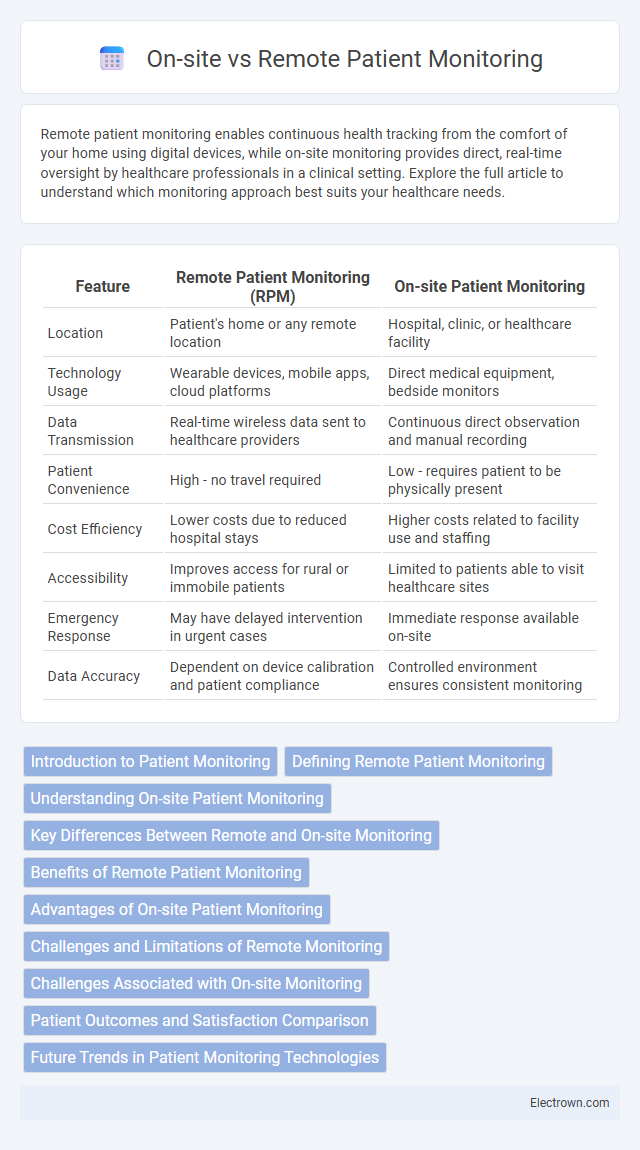Remote patient monitoring enables continuous health tracking from the comfort of your home using digital devices, while on-site monitoring provides direct, real-time oversight by healthcare professionals in a clinical setting. Explore the full article to understand which monitoring approach best suits your healthcare needs.
Table of Comparison
| Feature | Remote Patient Monitoring (RPM) | On-site Patient Monitoring |
|---|---|---|
| Location | Patient's home or any remote location | Hospital, clinic, or healthcare facility |
| Technology Usage | Wearable devices, mobile apps, cloud platforms | Direct medical equipment, bedside monitors |
| Data Transmission | Real-time wireless data sent to healthcare providers | Continuous direct observation and manual recording |
| Patient Convenience | High - no travel required | Low - requires patient to be physically present |
| Cost Efficiency | Lower costs due to reduced hospital stays | Higher costs related to facility use and staffing |
| Accessibility | Improves access for rural or immobile patients | Limited to patients able to visit healthcare sites |
| Emergency Response | May have delayed intervention in urgent cases | Immediate response available on-site |
| Data Accuracy | Dependent on device calibration and patient compliance | Controlled environment ensures consistent monitoring |
Introduction to Patient Monitoring
Patient monitoring involves continuous observation and assessment of a patient's health status using various medical devices and technologies. Remote patient monitoring (RPM) utilizes digital tools to collect health data outside traditional clinical settings, enabling real-time tracking and timely interventions. On-site patient monitoring relies on direct, in-person observation typically conducted within hospitals or clinics to manage acute and critical health conditions.
Defining Remote Patient Monitoring
Remote Patient Monitoring (RPM) involves the use of digital technologies to collect medical and health data from patients in one location and electronically transmit it to healthcare providers for assessment and recommendations. Unlike on-site monitoring, RPM enables continuous observation of vital signs, chronic condition management, and early detection of health issues without requiring patients to visit healthcare facilities. Your ability to receive timely medical intervention improves significantly through this seamless exchange of real-time data.
Understanding On-site Patient Monitoring
On-site patient monitoring involves continuous observation and evaluation of a patient's vital signs and health status within a healthcare facility, using advanced medical devices operated by trained professionals. This method ensures immediate intervention during emergencies and allows for accurate, real-time data collection critical for managing acute conditions. Your healthcare team relies on on-site monitoring to provide personalized, timely care that cannot be fully replicated in remote setups.
Key Differences Between Remote and On-site Monitoring
Remote patient monitoring utilizes digital technology to collect health data from patients outside traditional clinical settings, enabling continuous tracking and timely interventions. On-site monitoring requires patients to visit healthcare facilities where direct observation and real-time assessments by medical staff occur. You can benefit from remote monitoring's convenience and real-time data transmission, while on-site monitoring offers hands-on evaluation and immediate access to medical resources.
Benefits of Remote Patient Monitoring
Remote Patient Monitoring (RPM) enhances healthcare by enabling continuous data collection through wearable devices and mobile apps, improving early detection and management of chronic conditions such as diabetes and hypertension. RPM reduces hospital readmissions by providing real-time alerts to healthcare providers, facilitating timely interventions and personalized care plans. This approach also increases patient engagement and convenience by allowing monitoring from home, lowering overall healthcare costs and expanding access to medical services in rural or underserved areas.
Advantages of On-site Patient Monitoring
On-site patient monitoring provides direct access to medical personnel and immediate intervention during emergencies, ensuring rapid response and enhanced patient safety. It allows comprehensive use of advanced diagnostic equipment unavailable in remote settings, leading to more accurate and timely assessments. Continuous physical presence of healthcare providers facilitates personalized care and real-time adjustments to treatment plans based on observable patient conditions.
Challenges and Limitations of Remote Monitoring
Remote patient monitoring faces challenges such as inconsistent internet connectivity, device malfunctions, and patient data security concerns that can compromise care quality. Limitations include reduced physical examination capabilities and potential delays in identifying critical symptoms compared to on-site visits. Your ability to manage these issues depends on robust technology and effective patient education to ensure accurate data collection and timely intervention.
Challenges Associated with On-site Monitoring
On-site patient monitoring faces challenges such as limited accessibility for patients in remote or underserved areas, increased operational costs due to facility maintenance and staffing requirements, and potential delays in data collection and response times. The physical presence required for monitoring can strain healthcare resources and reduce flexibility for both patients and providers. Your ability to receive timely care may be impacted by these logistical and infrastructural constraints inherent in on-site monitoring systems.
Patient Outcomes and Satisfaction Comparison
Remote patient monitoring (RPM) significantly enhances patient outcomes by enabling continuous health data collection, leading to earlier detection of complications and personalized treatment adjustments. On-site monitoring offers direct clinical supervision, which can benefit complex cases but often limits patient convenience and engagement. Studies demonstrate higher satisfaction rates with RPM due to increased accessibility, reduced travel burdens, and improved communication between patients and healthcare providers.
Future Trends in Patient Monitoring Technologies
Future trends in patient monitoring technologies emphasize advanced remote monitoring systems integrated with AI-driven analytics to enhance real-time data accuracy and predictive health insights. On-site monitoring continues to evolve with improved sensor precision and interoperability, enabling seamless integration within hospital information systems. The convergence of wearable devices, IoT, and telehealth platforms is expected to transform patient care by enabling continuous, personalized monitoring across diverse healthcare settings.
Remote vs On-site Patient Monitoring Infographic

 electrown.com
electrown.com